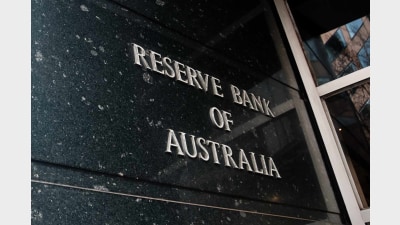Bullock quashes claims of RBA’s ‘pivot to neutral’ though economists remain optimistic


Governor Michele Bullock has quashed comments indicating that the RBA has pivoted to a neutral bias.
The Reserve Bank of Australia (RBA) held rates at 4.35 per cent on Tuesday but for the first time in a while, economists rejoiced in a perceived “dovish” tone from the bank.
Addressing the media post the board meeting, Bullock dispelled optimism, downplaying the wording in the board’s statement.
Namely, while the board said it is “not ruling anything in or out”, these words were perceived by some to indicate the board’s “verbal pivot” towards neutral especially since they replaced its previous phrase – “a further increase in interest rates cannot be ruled out”.
But Bullock brushed off indications of a pivot, saying instead that the RBA was responding to “some data”, which has demonstrated that “we are still on the path we thought we were on”.
“What the board is basically saying is we’re uncertain, we don’t know, we can’t rule in or out either,” Bullock said, indicating that the updated language simply better reflects the board’s thoughts,” she noted.
“We still believe we’re firmly on the narrow path.”
Regarding the possibility that the bank could entertain rate cuts later this year, the governor said the board would need more “confidence” that inflation is “coming back into the band”.
Only when the bank feels it is “overachieving” on the inflation front, can it debate a cut, Bullock said, adding that, at the moment, “we’re not seeing that”.
“We’re in a position where we are cautious, we want to wait and see. As I said, [there are] risks on both sides,” she said.
Bullock also evaluated that the November rate hike was appropriate, despite suggestions from economists that it could have been a tad oversensitive.
Commenting on whether a hike was on the table on Tuesday, the governor said the board considered “what was best”.
“Obviously, the board considers a range of possibilities and the possibility of a rate rise is something that the board might consider in terms of whether we’re at the right spot,” she said.
Bank not ruling anything ‘in or out’
In its post-meeting statement, the central bank reaffirmed its forecast for inflation to return to the target range of 2–3 per cent in 2025 and to the midpoint in 2026, with the path of interest rates said to “best ensure” this happens.
The bank noted that inflation is declining in line with RBA projections, even if service inflation remains “elevated” and there “is continuing excess demand in the economy and strong domestic cost pressures, both for labour and non-labour inputs”.
It also acknowledged that higher rates are establishing a more “sustainable balance between aggregate demand and supply”, leading to a gradual easing in labour market conditions, “although they remain tighter than is consistent with sustained full employment and inflation at target”.
Ultimately, the bank said it is “not ruling anything in or out”, reiterating that future rate decisions will be based on data, including developments in the global economy and trends in domestic demand.
Commenting on the board’s statement, GSFM investment strategist Stephen Miller was among a number of economists who perceived it as an indicator that the bank had stepped away from hawkishness towards a more dovish approach.
Namely, it was Miller who said the central bank has executed a “verbal pivot” from a tightening bias to a more neutral outlook.
The strategist evaluated that a rate cut could occur in the second half of the year, if the unemployment rate moves beyond the RBA projection of a 4.2 per cent average for the June quarter and if inflation tracks at the RBA projection.
While he described both of these scenarios as likely, he also warned that inflation that proves too “sticky” could upset any “emergent positive narrative”.
Dr Dwyfor Evans, head of APAC macro strategy at State Street Global Markets, described the RBA announcement as “a tad dovish” on Tuesday.
Similarly, the CBA’s Gareth Aird said “the removal of the hiking bias means the RBA board is now more confident they will not need to raise the cash rate again”.
“The weak Q4 23 GDP outcome coupled with the January monthly CPI indicator and recent labour market data would have fed into the decision to make the shift to a neutral bias,” the head of Australian economics said.
The CBA shares the broader market’s thoughts that the first cut will occur in September.
“We have 75 bp of rate cuts in our profile in late 2024 and a further 75 bp of easing in H1 25, which would take the cash rate to 2.85 per cent,” Aird said.
“We believe the risk now sits with August for the commencement of an easing cycle, provided the Fair Work Commission hands down a lift in the minimum and award wage of no more than 4.25 per cent.”
But some economists need further convincing, with Harvey Bradley, portfolio manager at Insight Investment, noting that “cuts will only be on the table around year end”.
HSBC chief economist Paul Bloxham has also been quite cautious, predicting that cuts aren’t on the cards until 2025.
Bullock herself refused to “opine” on whether or not the markets “have it right”, but pointed to the bank’s central forecasts that are conditioned on path that sees some decreases later in the year.
Recommended for you
As Australia gears up for the May budget, Treasurer Jim Chalmers has shed light on the significant global economic challenges that are shaping the nation’s fiscal decisions.
The central bank has announced its second interest rate decision since a major revamp.
The central bank has announced its first interest rate decision since a major revamp, which will see the board meet eight times a year instead of the original 11.
Former Blackrock executive, Justin Arter, has been appointed as the new chief executive of Cbus.









Add new comment